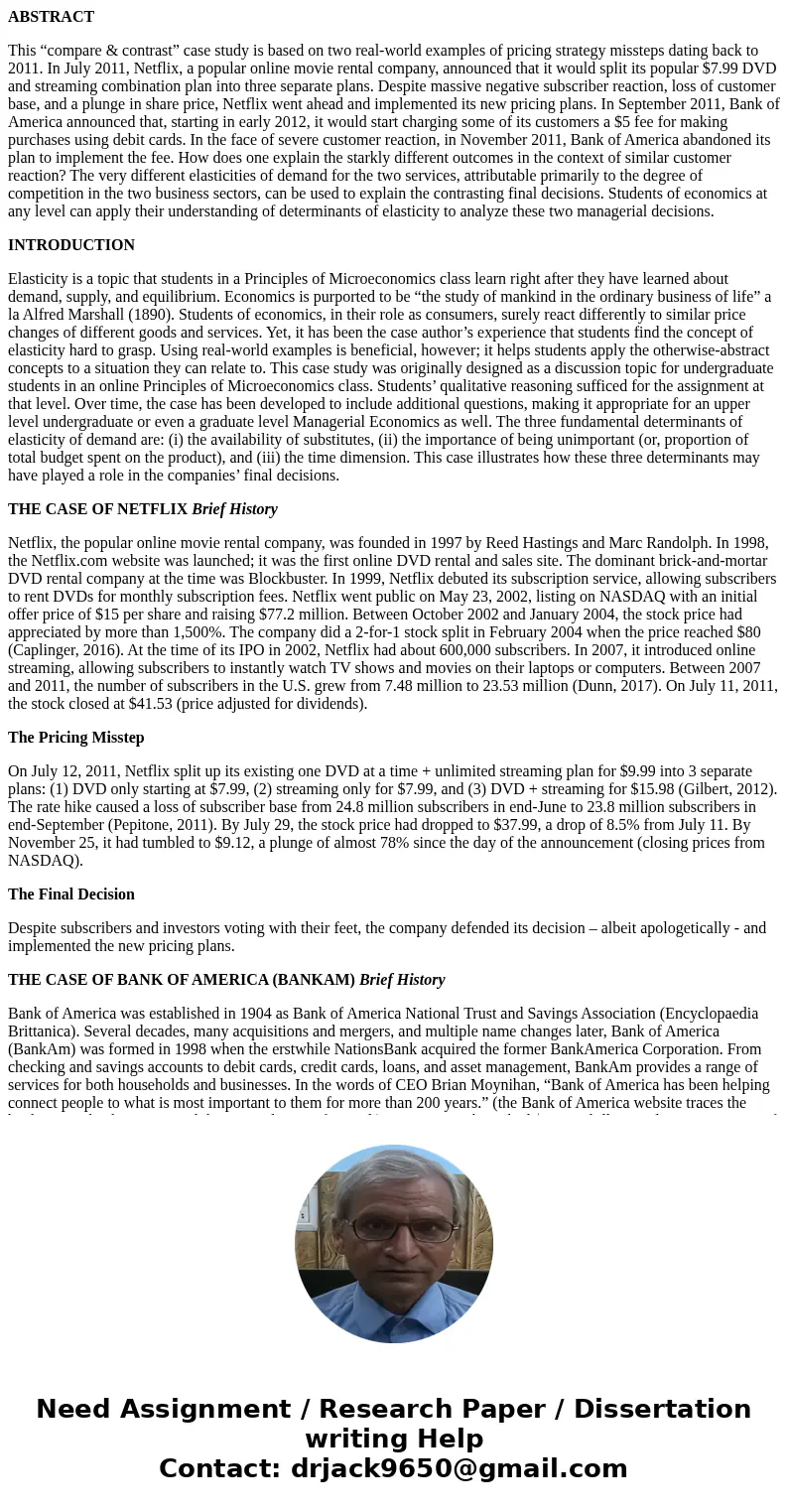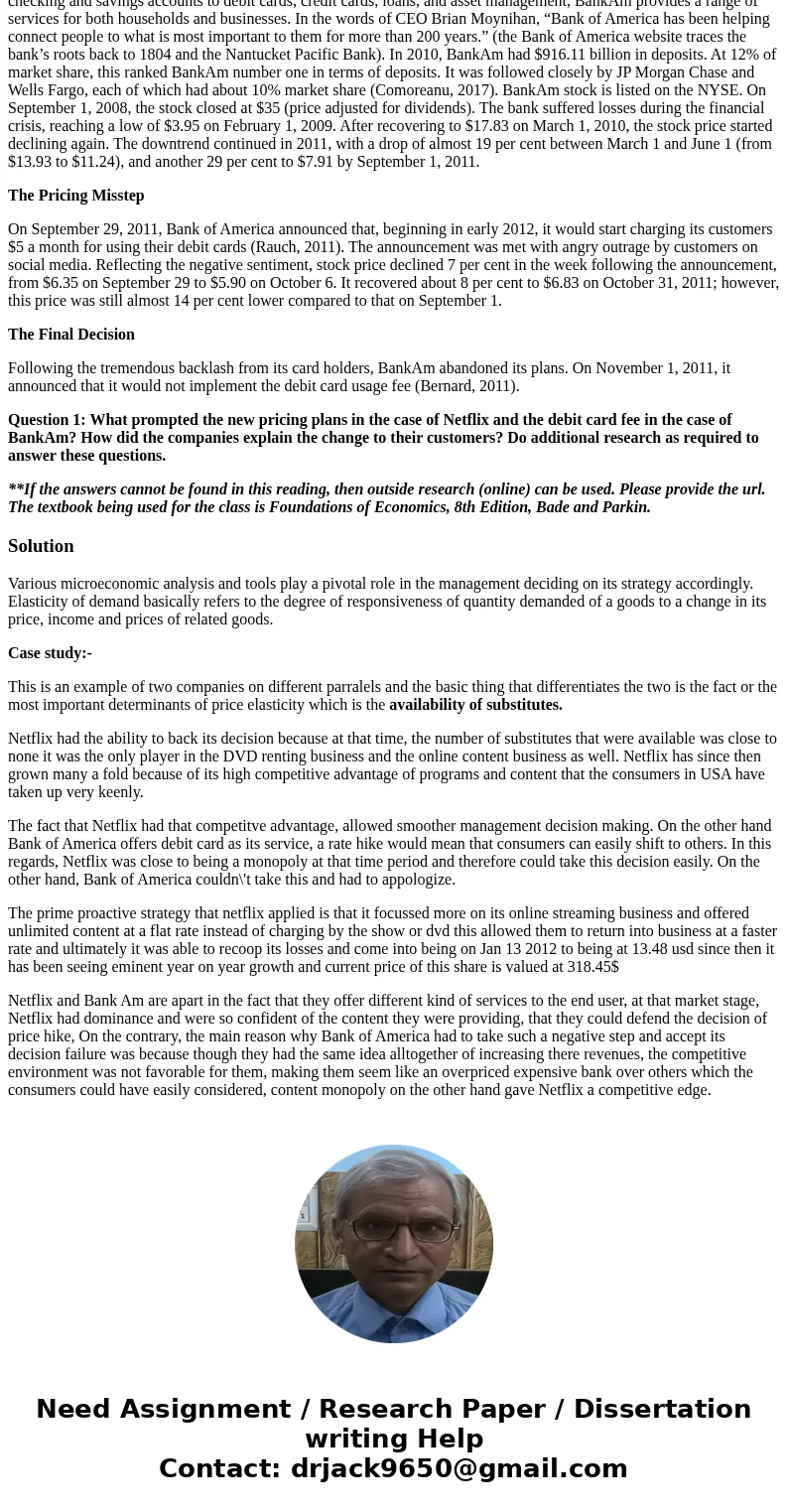ABSTRACT This compare contrast case study is based on two r
ABSTRACT
This “compare & contrast” case study is based on two real-world examples of pricing strategy missteps dating back to 2011. In July 2011, Netflix, a popular online movie rental company, announced that it would split its popular $7.99 DVD and streaming combination plan into three separate plans. Despite massive negative subscriber reaction, loss of customer base, and a plunge in share price, Netflix went ahead and implemented its new pricing plans. In September 2011, Bank of America announced that, starting in early 2012, it would start charging some of its customers a $5 fee for making purchases using debit cards. In the face of severe customer reaction, in November 2011, Bank of America abandoned its plan to implement the fee. How does one explain the starkly different outcomes in the context of similar customer reaction? The very different elasticities of demand for the two services, attributable primarily to the degree of competition in the two business sectors, can be used to explain the contrasting final decisions. Students of economics at any level can apply their understanding of determinants of elasticity to analyze these two managerial decisions.
INTRODUCTION
Elasticity is a topic that students in a Principles of Microeconomics class learn right after they have learned about demand, supply, and equilibrium. Economics is purported to be “the study of mankind in the ordinary business of life” a la Alfred Marshall (1890). Students of economics, in their role as consumers, surely react differently to similar price changes of different goods and services. Yet, it has been the case author’s experience that students find the concept of elasticity hard to grasp. Using real-world examples is beneficial, however; it helps students apply the otherwise-abstract concepts to a situation they can relate to. This case study was originally designed as a discussion topic for undergraduate students in an online Principles of Microeconomics class. Students’ qualitative reasoning sufficed for the assignment at that level. Over time, the case has been developed to include additional questions, making it appropriate for an upper level undergraduate or even a graduate level Managerial Economics as well. The three fundamental determinants of elasticity of demand are: (i) the availability of substitutes, (ii) the importance of being unimportant (or, proportion of total budget spent on the product), and (iii) the time dimension. This case illustrates how these three determinants may have played a role in the companies’ final decisions.
THE CASE OF NETFLIX Brief History
Netflix, the popular online movie rental company, was founded in 1997 by Reed Hastings and Marc Randolph. In 1998, the Netflix.com website was launched; it was the first online DVD rental and sales site. The dominant brick-and-mortar DVD rental company at the time was Blockbuster. In 1999, Netflix debuted its subscription service, allowing subscribers to rent DVDs for monthly subscription fees. Netflix went public on May 23, 2002, listing on NASDAQ with an initial offer price of $15 per share and raising $77.2 million. Between October 2002 and January 2004, the stock price had appreciated by more than 1,500%. The company did a 2-for-1 stock split in February 2004 when the price reached $80 (Caplinger, 2016). At the time of its IPO in 2002, Netflix had about 600,000 subscribers. In 2007, it introduced online streaming, allowing subscribers to instantly watch TV shows and movies on their laptops or computers. Between 2007 and 2011, the number of subscribers in the U.S. grew from 7.48 million to 23.53 million (Dunn, 2017). On July 11, 2011, the stock closed at $41.53 (price adjusted for dividends).
The Pricing Misstep
On July 12, 2011, Netflix split up its existing one DVD at a time + unlimited streaming plan for $9.99 into 3 separate plans: (1) DVD only starting at $7.99, (2) streaming only for $7.99, and (3) DVD + streaming for $15.98 (Gilbert, 2012). The rate hike caused a loss of subscriber base from 24.8 million subscribers in end-June to 23.8 million subscribers in end-September (Pepitone, 2011). By July 29, the stock price had dropped to $37.99, a drop of 8.5% from July 11. By November 25, it had tumbled to $9.12, a plunge of almost 78% since the day of the announcement (closing prices from NASDAQ).
The Final Decision
Despite subscribers and investors voting with their feet, the company defended its decision – albeit apologetically - and implemented the new pricing plans.
THE CASE OF BANK OF AMERICA (BANKAM) Brief History
Bank of America was established in 1904 as Bank of America National Trust and Savings Association (Encyclopaedia Brittanica). Several decades, many acquisitions and mergers, and multiple name changes later, Bank of America (BankAm) was formed in 1998 when the erstwhile NationsBank acquired the former BankAmerica Corporation. From checking and savings accounts to debit cards, credit cards, loans, and asset management, BankAm provides a range of services for both households and businesses. In the words of CEO Brian Moynihan, “Bank of America has been helping connect people to what is most important to them for more than 200 years.” (the Bank of America website traces the bank’s roots back to 1804 and the Nantucket Pacific Bank). In 2010, BankAm had $916.11 billion in deposits. At 12% of market share, this ranked BankAm number one in terms of deposits. It was followed closely by JP Morgan Chase and Wells Fargo, each of which had about 10% market share (Comoreanu, 2017). BankAm stock is listed on the NYSE. On September 1, 2008, the stock closed at $35 (price adjusted for dividends). The bank suffered losses during the financial crisis, reaching a low of $3.95 on February 1, 2009. After recovering to $17.83 on March 1, 2010, the stock price started declining again. The downtrend continued in 2011, with a drop of almost 19 per cent between March 1 and June 1 (from $13.93 to $11.24), and another 29 per cent to $7.91 by September 1, 2011.
The Pricing Misstep
On September 29, 2011, Bank of America announced that, beginning in early 2012, it would start charging its customers $5 a month for using their debit cards (Rauch, 2011). The announcement was met with angry outrage by customers on social media. Reflecting the negative sentiment, stock price declined 7 per cent in the week following the announcement, from $6.35 on September 29 to $5.90 on October 6. It recovered about 8 per cent to $6.83 on October 31, 2011; however, this price was still almost 14 per cent lower compared to that on September 1.
The Final Decision
Following the tremendous backlash from its card holders, BankAm abandoned its plans. On November 1, 2011, it announced that it would not implement the debit card usage fee (Bernard, 2011).
Question 1: What prompted the new pricing plans in the case of Netflix and the debit card fee in the case of BankAm? How did the companies explain the change to their customers? Do additional research as required to answer these questions.
**If the answers cannot be found in this reading, then outside research (online) can be used. Please provide the url. The textbook being used for the class is Foundations of Economics, 8th Edition, Bade and Parkin.
Solution
Various microeconomic analysis and tools play a pivotal role in the management deciding on its strategy accordingly. Elasticity of demand basically refers to the degree of responsiveness of quantity demanded of a goods to a change in its price, income and prices of related goods.
Case study:-
This is an example of two companies on different parralels and the basic thing that differentiates the two is the fact or the most important determinants of price elasticity which is the availability of substitutes.
Netflix had the ability to back its decision because at that time, the number of substitutes that were available was close to none it was the only player in the DVD renting business and the online content business as well. Netflix has since then grown many a fold because of its high competitive advantage of programs and content that the consumers in USA have taken up very keenly.
The fact that Netflix had that competitve advantage, allowed smoother management decision making. On the other hand Bank of America offers debit card as its service, a rate hike would mean that consumers can easily shift to others. In this regards, Netflix was close to being a monopoly at that time period and therefore could take this decision easily. On the other hand, Bank of America couldn\'t take this and had to appologize.
The prime proactive strategy that netflix applied is that it focussed more on its online streaming business and offered unlimited content at a flat rate instead of charging by the show or dvd this allowed them to return into business at a faster rate and ultimately it was able to recoop its losses and come into being on Jan 13 2012 to being at 13.48 usd since then it has been seeing eminent year on year growth and current price of this share is valued at 318.45$
Netflix and Bank Am are apart in the fact that they offer different kind of services to the end user, at that market stage, Netflix had dominance and were so confident of the content they were providing, that they could defend the decision of price hike, On the contrary, the main reason why Bank of America had to take such a negative step and accept its decision failure was because though they had the same idea alltogether of increasing there revenues, the competitive environment was not favorable for them, making them seem like an overpriced expensive bank over others which the consumers could have easily considered, content monopoly on the other hand gave Netflix a competitive edge.


 Homework Sourse
Homework Sourse